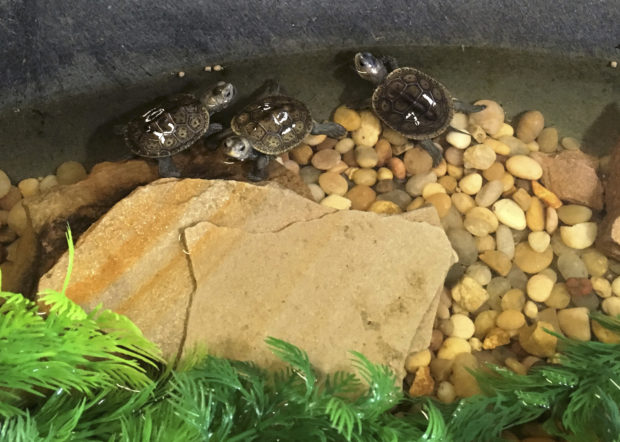
This September 2016 photo provided by the Louisiana Department of Wildlife and Fisheries, shows diamondback terrapins about a month after they hatched, at the Mandeville, Louisiana, home of Rachael and Stephen Creech. The turtles are being returned Thursday, July 6, 2017, to the barrier island where their mother laid the eggs. (Keri Landry/Louisiana Department of Wildlife and Fisheries via AP)
NEW ORLEANS—Twenty-one 11-month-old turtles are being returned to the Louisiana barrier island where their mothers laid the eggs from which they hatched.
The diamondback terrapin nests were dug up to protect the eggs during restoration of Cheniere Ronquille after the 2010 oil spill. Now that work is finished, and the 4- to 5-inch-long (10-centimer-long) turtles — hatched and raised by volunteers — are returning Thursday.
Diamondback terrapins, which live along the coast from Texas to New England, are the only U.S. turtle that lives in brackish waters. They may be best known as the University of Maryland’s mascot and as the turtles that stop traffic at New York’s JFK Airport when females trundle across the tarmac to look for sandy ground to lay their nests in June and July.
They’re listed as “near threatened” by the International Union for Conservation of Nature, as a species that could become threatened unless commercial trade is restricted. Habitat loss and sales to the Asian pet trade are among the biggest problems, according to the U.S. Fish and Wildlife Service’s application for that listing.
These turtle eggs were turned up about a year ago, when restoration crews supervised by the National Oceanic and Atmospheric Administration furrowed the island to ensure that no ground-nesting shorebirds would be laying eggs there, said Keri Landry, an endangered species biologist with the Louisiana Department of Wildlife and Fisheries.
She said dredged sediment was to be layered over the island, which would have buried the turtles’ nests about 2 feet (0.60 meters) deep, far beyond a hatchling’s ability to escape.
The crews turned up 10 or 12 nests over a week’s time, roping off each so Landry could collect the eggs. When she did, she marked each egg to show which end was up.
“After maybe a day or so, if you roll them, they’re not going to be viable,” said Stephen Creech, who hatched and raised the eggs. He said he and wife Rachael, owners of Adventure Pets in Mandeville, received 31 from Dave and Karen Milliken, whose incubators held the eggs for about a week last July.
Twenty-four hatched in August, and three hatchlings died. The rest have been growing since then in 150-gallon (568-liter) tubs with shallow brackish water, rocks and oyster shells for them to climb on, and ultraviolet lights and heated water to keep them warm.
“They’re beautiful. Mostly black and tan. Their heads are gray,” he said.
Creech says he also has a 10-inch-long (25-centimeter-long) full-grown female but plans to return her to the breeder who gave her to him.
He said he’d love to keep her in the pond in front of his store, “but she keeps chomping on my koi.” JPV